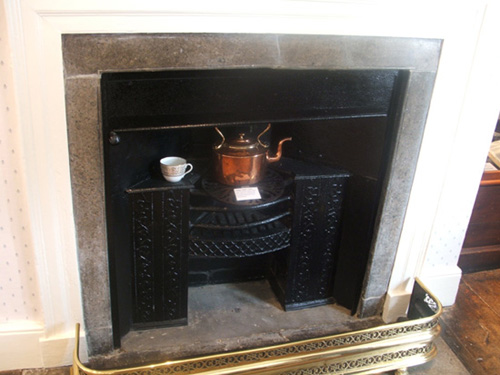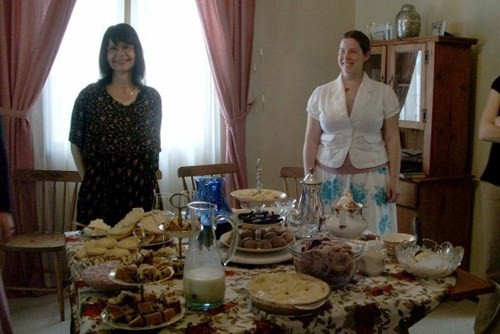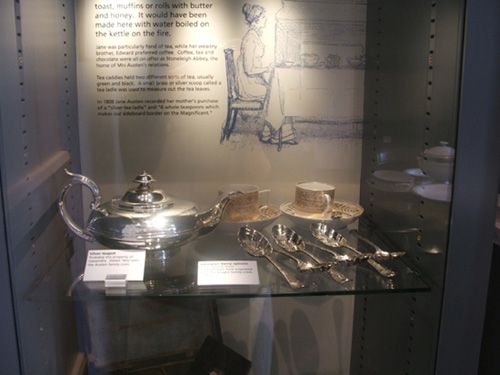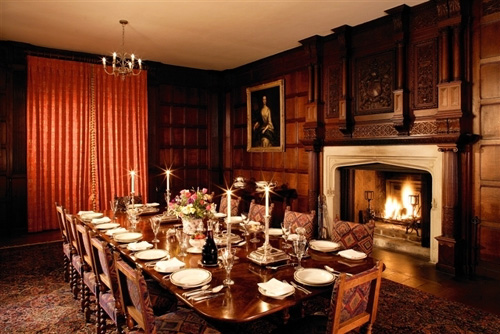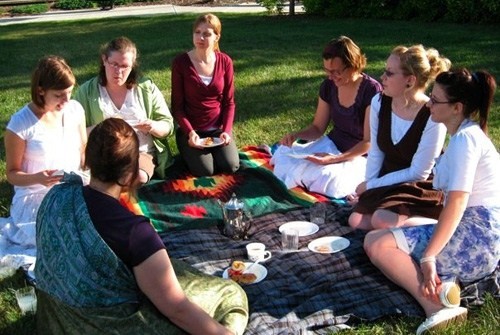|
In our fast-paced, individualist, coffee-driven culture, it is difficult for twenty-first-century students to realize the importance of subtle, sociable, tea-table interactions in Jane Austen’s time. In an attempt to familiarize the students in my 2006 “Jane Austen in Context” summer course with some of the cultural and culinary rituals that appear in Austen’s novels, I hosted a garden tea at my home.1 Paired with a variety of contextual readings in the course itself, from Richard Sheridan’s School for Scandal (1777) to Frances Burney’s Evelina (1778), the experience of the Jane Austen Tea helped the students realize the historical alterity of Austen’s world. They were so captivated by the experience that the same students requested a reunion tea the following summer. The summer after that, while I was away on a Chawton House Library fellowship in Hampshire, the students organized their own Jane Austen Tea in a public park, to which they invited me upon my return. The Jane Austen Tea has been a learning experience for me as well as for the students. We have learned that the organizing of a tea with refreshments is a complex task without the servants that were available to Austen’s heroines. We have also realized, however, that our gathering over tea generates significant social bonds, akin to the tea-table sympathies in Austen’s novels, as well as an understanding of some of the social aspects of Austen’s world and her fiction. †
The Jane Austen Tea has been gaining momentum, as the original students continue to gather year after year and add to their numbers by inviting fellow students, friends, and relatives. Originally, in 2006, I invited the students in my small summer course to my home. In the spring of 2007, I expanded the guest list, including students who had studied an Austen novel with me in any course, from the introductory “English Literature from Beginnings to Present” to senior-level courses such as “The Early English Novel” and “Advanced Studies in Romanticism.” The tea organized by the students in July of 2008 added new participants.
As the guest list expanded so did the culinary offerings. In 2006, students chose from Georgian and Regency recipes for a traditional tea, each following one of these recipes and bringing the results along with them. In 2007, many new culinary offerings were provided, from apple pie to whipped syllabub. One student even brought along an Austen quiz, to everyone’s delight. The 2008 tea organized by the students came complete with new recipes, such as home-made lemon ice cream.
Through the experience of preparation and consumption, the Jane Austen Tea serves as an introduction to some of the textures, tastes, and smells of Austen’s time. In reference to Regency dance, Austen scholar Celia Easton has raised the question, “Can we know literature through the body, as well?” (252). Easton’s question is equally applicable to students’ wrestling with Regency recipes. Publications such as Maggie Black and Deirdre Le Faye’s Jane Austen Cookbook (1995), Maggie Lane’s Jane Austen and Food (1995), and Kim Wilson’s Tea with Jane Austen (2004) facilitate the introduction of students to the culinary rituals of Austen’s time.
While the savory dishes in Black and Le Faye’s cookbook—such as A Harrico of Mutton, Pheasant à la Braise, and Chicken with Hog’s Tongues—are daunting, the sweets appear more approachable. When I first suggested trying out some Regency baking for a Jane Austen Tea, the students each enthusiastically chose a recipe from either The Jane Austen Cookbook or Tea with Jane Austen.2 They discovered that some of the steps and ingredients required were quite alien and that Georgian and Regency cooking involved slow and careful processes unfamiliar to them. As they arrived at my home with the results of their applied study, the students shared stories about the difficulty of finding ingredients such as orange flower water. One student, Vicki Black, reflected,
When I attended the Jane Austen Tea, it was eye-opening! It was through attempting to prepare a confection from Austen’s time that I found out how time-consuming the process of cooking and baking was! Dishes that may today take us two or three hours to bake altogether would have taken a day or two without the modern conveniences of pre-made pastries and jams.
Vicki appreciated the experientially-based knowledge that she gleaned not only from studying and following a Regency recipe but also from attending a tea where students found themselves behaving with more propriety and sitting up straighter than usual.
The Jane Austen Tea introduces students to other dimensions of the world of early nineteenth-century England. In Austen’s time, a full, formal tea required dutiful servants to prepare the food and an elegant space within which to serve it. The tea itself was often steeped and poured by a young woman of the house, such as Jane Bennet, Fanny Price, or Emma Woodhouse: “In Jane Austen’s time, servants almost never prepared the tea . . . because tea was too expensive to be trusted to them” (Wilson 76). Finer class distinctions accrued to the time tea was consumed. Agricultural laborers would drink their tea at the end of the workday, during the hours of natural sunlight, when expensive candles were unnecessary. Country squires and urban professionals, on the other hand, would have their tea much later, sometimes at the end of an evening’s entertainment such as a play or an opera. Deirdre Le Faye explains that amongst the more privileged classes, after dinner,
[i]n summer a gentle stroll in the grounds or to some urban promenade might follow, while in winter the family and guests would gather round the fire in the drawing-room for cards, conversation, perhaps impromptu music and dancing, until tea, accompanied by cakes or similar light refreshments, was served there at about eight o’clock. (Black and Le Faye 9)
This routine explains why Jane Austen was afraid that her sister Cassandra would “despise” her own family at Steventon for drinking “tea at half after six” (qtd. in Lane 37) when Cassandra had been exposed to more sophisticated hours at Godmersham, where her brother Edward lived as a country squire.
Tea at Chawton Cottage, where Jane Austen lived with her mother and sister while revising her early novels and writing her final three, would have been a more modest affair. What Claudia Johnson terms the “genuine relics of Austen” (218) in Chawton Cottage include a small silver teapot that bears the Austen family crest and, according to the wistful note card, was “probably the property of Cassandra.”
The reading material behind the teapot directs the visitor’s gaze to the Chawton Cottage hearth (see Fig. 1), with kettle strategically placed, and explains that tea “would have been made here with water boiled with the kettle on the fire” (my italics). The modesty of Cassandra’s small silver teapot and the plainness of the Chawton Cottage hearth become apparent when they are compared to Edward (Austen) Knight’s long dinner table, full silver setting, and large fireplace at Chawton House, one of the three country estates he owned. Through examining the material remains alone, the visitor to Chawton Cottage and Chawton House imagines that the Austen women, though still aided by a servant, would have had much humbler gatherings over tea than those hosted by Edward Knight in his more lavish surroundings.
Aware of the tensions between masculine privileges of inheritance and wealth and feminine practices of economy and frugality in novels like Sense and Sensibility, Pride and Prejudice, and Mansfield Park, my students see our Jane Austen Tea as paradoxically countercultural and even feminist as well as traditional and domestic. As we gathered in the “garden” (my backyard) for the first Jane Austen Tea, one student, Natalie McIntyre, brought out an antique silver teapot that was a gift from her grandmother. A bright, independent young woman, this student laughed about how she had been keeping the teapot in her hope chest and then remarked wryly that as she did not know when she would be married she was happy to share the silver teapot with us. Though for our twenty-first-century Jane Austen Tea we conveniently boiled our water on the stovetop, when Natalie carefully unwrapped and presented her silver heirloom, she drew our attention to familial and social ties that cross centuries as well as continents. Her subtle, ironic comments regarding topics such as marriage and gender expectations both foregrounded and resisted such ties, highlighting the fact that by gathering as a group of young women, in the memory of a female author, she and her fellow students move against the grain of their educational heritage. The liberal arts university where I teach was once a bible college, or “bridal college,” as such institutions are insensitively called, and it has not strayed far from its conservative roots.
Those students at the private Christian university where I teach who are brave enough to take a course focused on the unmarried Jane Austen represent a different type of young evangelical woman, one akin to Austen’s contemporary Hannah More, whose faith motivated her boldly to write against slavery and initiate educational reform.3 Natalie McIntyre’s reflections highlight the paradoxically feminist nature of the Jane Austen Tea:
The experience of gathering with other women for tea was very eye-opening. As each of us arrived, I had a glimpse of what the daily life represented in Jane Austen novels might have been like. These gatherings would have been so important for the women, a time when they could share daily problems, discuss the latest novel, or just interact with other people and have some entertainment. That social network would have been so important.4
When I serve the students tea in cups I have myself inherited from my feisty and independent Scottish grandmother, I too sense that I am continuing a tradition of feminine hospitality that holds potential for social transformation.
The feminist undercurrents of our Jane Austen Teas became highly evident when our third gathering was interrupted by a message from a young man. One of the participants was checking text messages on her cell phone at the tea, and the others asked:
Who are the messages from? Oh, just a guy from work. He asked me what I am doing. I have told him I am at a Jane Austen Tea. He replied, “Sick, I would be violently ill if I had to be there.”
There was a moment’s pause, and then, in rapid-fire succession:
What a proud and disagreeable young man. Yes, most disagreeable, horrid, and not at all worth pleasing. So high and conceited! He fancies himself so very great! Yes, shockingly rude!
The allusions to the Bennet family’s initial perceptions of Mr. Darcy in Pride and Prejudice abounded freely and playfully, as the students modeled Elizabeth’s vivacity and “great spirit among her friends” (P&P 12). In a spontaneous and improvisational display of what Emily Hollingshead termed “freedom in community,” the young women banded together and drew on their deep knowledge of Austen’s words to repel the arrogant attack of this young man. It was a joy to witness their wit and grace culminate in peals of laughter.
The Jane Austen Tea, then, helps us become more aware of how Austen uses tea-time to generate and sustain humor, sympathy, familial love, and romantic attachment among her characters. The tea-table is a profoundly social space in Austen’s novels—as it was in her world. In her fiction, Jane Austen deploys ideas about tea that were circulating in her culture to delightful, at times comic, ends.
In her novels, Jane Austen creates humor by satirizing the arrogance and social pretention that can arise over tea. This comic Horatian satire often has socioeconomic inflections that interweave a skein of trenchant social critique through Austen’s narratives. With its connotations of class privilege, the idea of a late evening tea momentarily becomes a target of social satire in Sense and Sensibility. The pretentious Robert Ferrars misinterprets the Dashwood women’s vulnerable and restricted situation at Barton Cottage when he proposes a plan for an extravagant town tea in similarly cramped quarters. He declares, “‘I am excessively fond of a cottage; there is always so much comfort, so much elegance about them’” (251) and then claims that a cottage dweller could host “‘eighteen couple with ease’” if “‘card-tables [were] placed in the drawing-room; the library . . . open for tea and other refreshments’” (252). This scheme exposes Robert Ferrars’s insensitivity and superficiality; his preference for forced social display over peaceful solitary or familial pursuits, like reading. After Robert Ferrars has presented his plan in all its fine and outrageous detail, Austen’s narrator remarks, “Elinor agreed to it all, for she did not think he deserved the compliment of rational opposition” (252). Robert’s plan for fashionable cottage hospitality offends Elinor’s reason. Its irrational luxury no doubt reminds her of his earlier “delicacy of . . . taste” (220) in vacillating over the purchase of a jeweled toothpick-case in a London shop where she had come to exchange her mother’s jewelry. In both instances, Elinor’s straightened circumstances and common sense act as foils for Robert Ferrars’s wasteful urbanity and snobbishness. Austen’s inclusion of late evening tea among Robert Ferrars’s vanities warns readers against its potential elitism.
Austen’s more sympathetic characters, however, often form sincere and sustaining social connections over tea. Again in Sense and Sensibility, the amiable and loyal Colonel Brandon expresses his deep concern and compassion for Marianne Dashwood at “the tea-table where Elinor presided” (198). Later Elinor, as she watches over Marianne’s sickbed, finds a moment of soothing friendship when Mrs. Jennings coaxes her to join her for tea. After Marianne has begun to show steady signs of recovery, Elinor allows herself to indulge in the nourishment that comes with tea as a much needed form of physical and emotional refreshment:
At seven o’clock, leaving Marianne still sweetly asleep, she joined Mrs. Jennings in the drawing-room to tea. Of breakfast she had been kept by her fears, and of dinner by their sudden reverse, from eating much;—and the present refreshment, therefore, with such feelings of content as she brought to it, was particularly welcome. (315)
This association between tea and emotional refreshment is perhaps why director Ang Lee and actress Emma Thompson take time to depict Elinor Dashwood composing herself with a cup of tea early in their 1995 film version of Sense and Sensibility.
Austen uses the tea-table to signify sincere and restorative connections of familial love in Northanger Abbey. After General Tilney has unceremoniously ousted Catherine Morland from his home, and she has travelled all day and into the evening in a “hack post-chaise” (232) to reach her home at Fullerton, her family welcome her warmly to tea. She has been apart from them for eleven weeks and finds herself “soothed beyond any thing that she had believed possible” as she is “surrounded” and “caressed” by her parents and siblings.
In the joyfulness of family love every thing for a short time was subdued, and the pleasure of seeing her, leaving them at first little leisure for calm curiosity, they were all seated round the tea-table, which Mrs. Morland had hurried for the comfort of the poor traveller, whose pale and jaded looks soon caught her notice, before any inquiry so direct as to demand a positive answer was addressed to her. (233)
Mrs. Morland, like Mrs. Jennings with Elinor in Sense and Sensibility, understands the need for physical nourishment provided by the food that accompanies tea. For Elinor Dashwood and Catherine Morland, the refreshment of the tea-table takes on an almost therapeutic quality. Near the very end of the novel, the narrative of Northanger Abbey also hints at the romantic possibilities that the tea-table can offer. Mrs. Allen remarks that Henry Tilney, with whom Catherine is in love, first proved himself “‘so very agreeable’” when he “‘drank tea’” (238) with Catherine and the Allens at Bath.
Though Maggie Lane astutely notes that in Mansfield Park the arrival of tea can deliver a woman from the unwanted attention of a man,5 generally teas in Austen’s novels hold the potential for solidifying romantic as well as sociable and familial bonds. A very important romantic interaction between a man and a woman during tea occurs in Pride and Prejudice. Near the end of the narrative, as Mrs. Bennet’s guests gather after dinner in the Longbourn drawing room, Jane makes tea and Elizabeth pours coffee at the same “tea-table.” Lane observes, “Although the ceremony was invariably known as ‘tea,’ coffee was also available,” and “coffee is drunk very frequently in Pride and Prejudice” (50). When Mr. Darcy “bring[s] back his coffee cup himself” (P&P 341) to the tea-table in an act of shared domestic responsibility, Elizabeth’s hopes that the evening will “afford some opportunity of bringing them together” (340-41) are fulfilled. Their conversation over the tea-table, more intimate than general civilities over the larger dinner table, accelerates their eventual union.
One of the most delightful teas in all of Austen’s novels involves the small gathering of Mr. Woodhouse, Mr. Knightley, and Emma Woodhouse near the end of Emma’s narrative. Mr. Knightley has declared his love to Emma, but her father is still unaware of their romantic attachment. These circumstances transform the seemingly mundane details of this tea at Hartfield into an almost spiritual experience of pregnant silence and barely contained rapture: They sat down to tea—the same party round the same table—how often it had been collected!—and how often had her eyes fallen on the same shrubs in the lawn, and observed the same beautiful effect of the western sun!—But never in such a state of spirits, never in anything like it; and it was with difficulty that she could summon enough of her usual self to be the attentive lady of the house, or even the attentive daughter. (434) The view of tea has shifted radically here from its earlier ageist associations with the past-times of the elderly Mr. Woodhouse and Mrs. Bates, a character who the narrator at first describes as “a very old lady, almost past every thing but tea and quadrille” (21). Later, Austen represents Emma asking her friends “to all go in and drink tea” (344) with the elderly Mr. Woodhouse, but the reader senses she still sees this kind of gathering as a duty. In Emma’s penultimate, Romantic tea, after Mr. Knightley has confessed his love, he and Emma sit together with Mr. Woodhouse, holding tight to their secret and pondering it in their hearts. Rather than a sociable bond of feminine friendship or familial affection sustained through conversation over tea, here a decidedly romantic bond between a man and a woman solidifies silently as Emma performs the rituals of tea.
Our twenty-first-century Jane Austen Teas have so far invigorated the students’ intellectual, and familial, but not necessarily romantic connections. Though weddings and engagements have been discussed at the teas, no young men have actually attended them. The community created within the teas themselves has been entirely female. At the first tea, in 2006, some of the students shared how their mothers had helped them with the recipes, causing me to realize that the project had created female community between mothers and daughters, as well as among the students themselves. At the second tea, in 2007, the attendance more than doubled, and a mother even came along with her daughter, but still no men were present. At the third tea in 2008 a young man’s voice was certainly heard through his text message, triggering a communal response of witty repartee. Some of the joy and laughter at these teas is due to their support of ties between women, of friendship, as well as of motherly and sisterly love.
The organizer of the third tea, Emily Hollingshead, commented,
There seems to be something about Jane Austen that gives us permission to be a little silly: to dress up for a picnic; to eat strange-looking food because it’s what Elizabeth Bennet might have eaten; to rehash the debate between this and that movie adaptation for the fourteenth time; and at our third Jane Austen Tea, with Emma Webster’s Lost in Austen, to try our own hands at plotting the stories of Austen’s heroines. That freedom in community is one of the things I love best about reading Jane Austen!
Each of these events created a strong sense of literary and culinary community between women, demonstrating that the Austen legacy of laughter over tea lives on.
Like many fruitful pedagogical experiments, the Jane Austen Tea has raised more questions than it has answered, both for the students and for me. Have we altered the “authenticity” of the Jane Austen Tea by making it an exclusively female, even feminist, gathering? Should we look more carefully at the ways in which Austen both celebrates and critiques the rituals of tea? How can we avoid replicating Robert Ferrars’s snobbishness even as we cherish and share family heirlooms such as silver teapots and English Rose china? How can we be more inclusive in our hospitality? One young man has expressed interest in participating in this fall’s “Jane Austen in Context” course. Will he bake for the next tea? Will the laughter over tea stop due to his presence, or will it find a new focus? Will the students find fresh forms of “freedom in community” shared between young women and young men? Based on the success of the pedagogical experiment thus far, I am excited to see what new fruit future Jane Austen Teas will bear. Notes 1. This course borrows its title from an admirable, inspiring, and informative collection of essays on Austen’s historical and cultural context edited by Janet Todd.
2. The students bake for the Jane Austen Tea with a full awareness that Austen herself, like her protagonists, was exempt from cooking, a task reserved for servants. Le Faye carefully explains that in The Jane Austen Cookbook “the dishes chosen are those that [Austen] and her family, and the characters in her novels, would have eaten” (Black and Le Faye 7) but not prepared.
3. For further reading on Hannah More and networks of feminine influence see Elizabeth Eger (294-97). More’s “Slavery, A Poem” was structured rhetorically as an abolitionist speech in verse and eventually read aloud in parliament. For analysis of this poem in the context of women’s abolitionism, see Ferguson (148-54).
4. Harriet Guest notes similar imagery of “a feminine sociable currency” (191) in More’s poetry.
5. Maggie Lane refers briefly to Fanny Price’s deliverance from Henry Crawford’s attentions by the arrival of tea and cakes at Mansfield Park (50). Works Cited Austen, Jane. The Novels of Jane Austen. Ed. R. W. Chapman. 3rd ed. London: Oxford UP, 1933-69. Black, Maggie, and Deirdre Le Faye. The Jane Austen Cookbook. Chicago: Chicago Review P, 1995. Easton, Celia. “Dancing Through Austen’s Plots: A Pedagogy of the Body.” Persuasions 28 (2006): 251-55. Eger, Elizabeth. “‘The noblest commerce of mankind’: Conversation and Community in the Bluestocking Circle.” Women, Gender, and Enlightenment. Ed. Sarah Knott and Barbara Taylor. New York: Palgrave, 2005. 288-305. Ferguson, Moira. Subject to Others: British Women Writers and Colonial Slavery, 1670-1834. New York: Routledge, 1992. Guest, Harriet. Small Change: Women, Patriotism, Learning, 1750-1810. Chicago: U of Chicago P, 2000. Johnson, Claudia L. “Jane Austen’s Relics and the Treasures of the East Room.” Persuasions 28 (2006): 217-32. Lane, Maggie. Jane Austen and Food. Rio Grande: Hambledon P, 1995. Sense and Sensibility. Writer Emma Thompson and Director Ang Lee. Perf. Hugh Grant, Alan Rickman, Emma Thompson, Kate Winslet. Sony Pictures, 1995. DVD. Todd, Janet, ed. Jane Austen in Context. Cambridge: Cambridge UP, 2005. Wilson, Kim. Tea With Jane Austen. Madison: Jones Books, 2004. |


